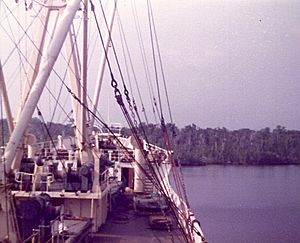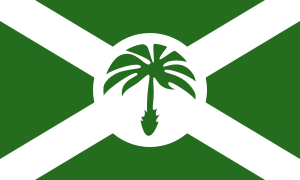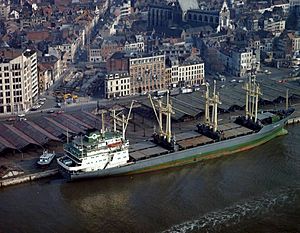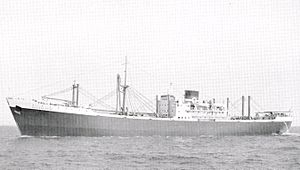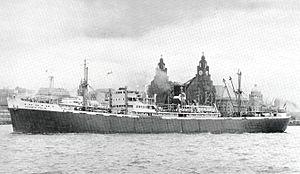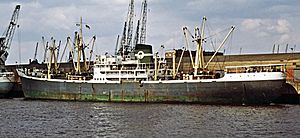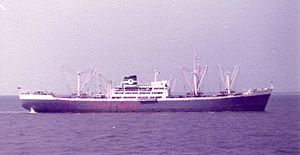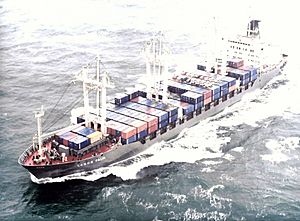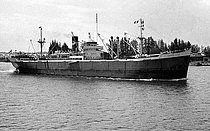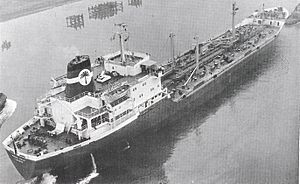Palm Line facts for kids
| Subsidiary of United Africa Company (UAC) | |
| Industry | Shipping |
| Successor | Ocean Transport & Trading in 1985 |
| Founded | 1911, as Southern Whaling and Sealing Company Ltd |
| Defunct | 1986 |
| Headquarters | UAC House, Blackfriars Road, London, United Kingdom |
|
Area served
|
Northern Europe, West Africa and Mediterranean |
|
Key people
|
Frank Samuel (First Chairman) Lord Cole, Chairman 1952-55 |
| Parent | Unilever |
The Palm Line was a British shipping company. It operated ships that sailed to West Africa from 1949 until 1986. Their main job was to serve ports along the long 5,000-mile coastline from Morocco in the north all the way down to Angola in the south.
Palm Line was part of important shipping groups like UKWAL and COWAC. They worked with other well-known shipping lines such as Elder Dempster and Nigerian National Shipping Line.
Contents
The Story of Palm Line
After World War II, in the late 1940s, a big company called UAC decided to make its shipping fleet a separate business. So, on February 16, 1949, they created a new company. They did this by using the old rules of a company called Southern Whaling and Sealing Company, which had been bought by Lever Bros. years before. They simply changed its name to Palm Line.
Choosing the name "Palm" was a big decision! At one point, they thought about calling it "Sun Line." But it was Mr. Frank Samuel, who later became the company's first chairman, who came up with the name "Palm."
Did you know that most Palm Line ships built before 1970 had to be shorter than 152 meters (500 feet)? This was so they could sail through the narrow rivers and "creeks" in Nigeria. The depth of the water, called "draught," was also very important. The coast of West Africa is quite flat, and slow rivers create long sand bars near the shore.
To enter most rivers, ships had to cross over these sand bars. The deepest a ship could be was about 8.2 meters (27 feet) to reach all ports. For some rivers, like the Escravos River that leads to Sapele, ships couldn't carry more than 4,000 tons of cargo. This was because the water over the Escravos Bar was only about 5.2 meters (17 feet) deep. So, ships often had to cross a different bar and then use a connecting creek to reach the Escravos River.
The Krooboys: Local Crew Members
It was a common practice for all Palm Line ships to stop at Freetown (in Sierra Leone) when sailing both north and south. Here, they would refuel and pick up "Krooboys." These were extra local West African crew members. Their main jobs were chipping paint, cleaning the ship, and cleaning the cargo holds. They had their own living areas on the ship's deck, and their leader even had his own cabin at the front of the ship.
The End of an Era
The early 1980s marked the beginning of the end for Palm Line. From 1982 to 1986, there was a big drop in trade between Europe and West Africa. This meant Palm Line had to rent out its ships to other companies more and more. In 1986, Palm Line was sold to Ocean Fleets. The last chairman of Palm Line was Gordon Williams.
The Palm Tree Emblem
The palm tree symbol, which became Palm Line's emblem, was actually used on a Unilever Ltd flag way back in 1939.
Palm Line at the Museum
From June to December 2018, the Merseyside Maritime Museum in England had a special exhibit called "Palm Line - A new company for a new era." The main attraction was a detailed model of the ship MV Matadi Palm (built in 1970).
The Fleet of Palm Line
Palm Line had many ships over the years. Here are some of them:
| Ship | Built | Shipyard | IMO Number | Speed (knots) | Type | GRT | Notes |
| MV Africa Palm | 1953 | Short Brothers | 5004075 | 11 | General Cargo | 5,415 | Sister ship to MV Burutu Palm (1953). Sold in 1972. Caught fire in 1975 and was later scrapped. |
| MV Africa Palm | 1971 | Warnowwerft | 7125328 | 14 | General Cargo | 10,008 | Bought by Palm Line in 1974. Was renamed Santa Barbara Pacific for a short time in 1983. |
| MV Akassa Palm | 1958 | Bremer Vulkan | 5006712 | 14 | General Cargo | 9,000 | Sold in 1972 and renamed Elenma. Scrapped in 1984. |
| MV Andoni Palm | 1958 | Bremer Vulkan | 5016391 | 14 | General Cargo | 9,000 | Sold in 1976 and scrapped in 1982. |
| MV Apapa Palm | 1973 | Stocznia Szczecińska | 7305801 | 16 | General Cargo | 9,417 |
Bought by Palm Line in 1977. Two sister ships were used in the Falklands War. Sold in 1985. |
| MV Ashanti Palm | 1947 | Shipbuilders Corporation | n/a | 10½ | General Cargo | 5,123 | Sank in Naples harbor in 1962 during a fierce storm. No one was hurt. |
| MV Badagry Palm | 1956 | Swan, Hunter & Wigham Richardson | 5033521 | 14 | General Cargo | 5,042 | Carried Dr. Kwame Nkrumah to London. Sold in 1972 and scrapped in 1981. |
| MV Badagry Palm | 1979 | Sunderland Shipbuilders | 7726873 | 16 | General Cargo | 12,279 | Carried the very last engine built by Doxford. Sank in 1996 with all 23 crew members during a storm off South Africa. |
| MV Bamenda Palm | 1956 | Swan, Hunter & Wigham Richardson | 5035440 | 14 | General Cargo | 5,154 |
Sold in 1972 and scrapped in 1983. |
| MV Bamenda Palm | 1979 | Hyundai Heavy Industries | 7725843 | 16 | General Cargo | 11,223 |
Built in South Korea. In 1980, it accidentally hit another ship during a storm. Later renamed several times and scrapped in 2009. |
| SS Benin Palm | 1936 | Deschimag Seebeck | n/a | General Cargo | 5,424 | Sold in 1959. | |
| SS Burutu Palm | 1936 | General Cargo | 5,424 | ||||
| MV Burutu Palm | 1953 | Short Brothers | 12 | General Cargo | 5,410 | Sister ship to MV Africa Palm (1953). Sank in 1973 after hitting a reef. | |
| SS Dahomey Palm | 1937 | Furness Shipbuilding Company | n/a | General Cargo | 4,876 | Sold in 1959 and broken up in 1968. | |
| MV Elmina Palm | 1957 | Swan, Hunter & Wigham Richardson | 5102372 | 14 | General Cargo | 5,356 | One of the first British cargo ships to use a lot of aluminum. Sold in 1977. |
| MV Enugu Palm | 1958 | Swan, Hunter & Wigham Richardson | 5104722 | 14 | General Cargo | 7,963 | Sold in 1978. |
| MV Gambia Palm | 1937 | Deutsche Schiff- und Maschinenbau AG | n/a | General Cargo | 5,452 |
Seized during WWII, then returned. Sold to Palm Line in 1949. Scrapped in 1963. |
|
| MV Ibadan Palm | 1959 | Swan, Hunter & Wigham Richardson | 5157767 | 14 | General Cargo | 5,658 | Sister ship of the Ilorin Palm. Sold in 1978 and broken up in 1983. |
| MV Ikeja Palm | 1961 | Swan, Hunter & Wigham Richardson | 5158553 | 14 | General Cargo | 5,816 | Sister ship of Ilesha Palm. Sold in 1981. |
| MV Ilesha Palm | 1961 | Swan, Hunter & Wigham Richardson | 5158785 | 14 | General Cargo | 5,816 |
Sister ship of the Ikeja Palm. Sold in 1979 and scrapped in 1984. |
| MV Ilorin Palm | 1960 | Swan, Hunter & Wigham Richardson | 5159105 | 14 | General Cargo | 5,658 |
Sister ship of the Ibadan Palm. Sold in 1979 and scrapped in 1982. |
| SS Kano Palm | 1936 | Howaldtswerke | n/a | General Cargo | 5,129 | Sold in 1954. | |
| MV Kano Palm | 1958 | Swan, Hunter & Wigham Richardson | 5181342 | 14¼ | General Cargo | 8,734 | Sister ship of the Katsina Palm (1957). Sold in 1979 and scrapped in 1982. |
| MV Katsina Palm | 1957 | Swan, Hunter & Wigham Richardson | 5183883 | 14¼ | General Cargo | 8,734 | Sister ship of the Kano Palm (1958). Sold in 1978 and broken up in 1984. |
| SS Kumasi Palm | 1943 | Furness Shipbuilding Company | n/a | General Cargo | 7,221 | Sold in 1960. | |
| SS Lagos Palm | 1947 | Shipbuilders Corporation | 5261271 | General Cargo | 5,047 | Renamed Oguta Palm in 1960, then sold and scrapped in 1973. | |
| MV Lagos Palm | 1961 | Swan, Hunter & Wigham Richardson | 5202275 | 16 | General Cargo | 6,256 |
Sister ship of the Lobito Palm. Wrecked in 1983 and broken up in 1984. |
| MV Lagos Palm | 1982 | Stocznia Szczecińska | 7822768 | 16 | General Cargo | 15,575 |
Chartered in 1984, then sold in 1986. Had many name changes before being broken up in 2009. |
| MV Lobito Palm | 1960 | Swan, Hunter & Wigham Richardson | 5210143 | 16 | General Cargo | 6,256 |
Sister ship of the Lagos Palm (1961). Sold in 1979 and scrapped in 1983. |
| SS Lokoja Palm | 1947 | Shipbuilding Corporation Ltd | 5210973 | 10½ | General Cargo | 5,122 |
A standard cargo ship from wartime. Sold in 1966 and broken up in 1971. |
| MV Lokoja Palm | 1982 | Stocznia Szczecińska | 7822770 | 16 | General Cargo | 15,576 | Often chartered to a German company and renamed Wameru. Sold in 1986. |
| MV Makeni Palm | 1951 | Joseph L. Thompson and Sons | 5218028 | Oil Carrier | Bought in 1961. Sold in 1967 and scrapped in 1978. | ||
| MV Makurdi Palm | 1953 | AG Weser Seebeckwerft | 5218080 | Oil Carrier | See MV Tema Palm. | ||
| MV Matadi Palm | 1948 | Sir James Laing & Sons | Oil Carrier | 6,246 | Sold for scrap in 1963. | ||
| MV Matadi Palm | 1970 | Swan Hunter | 7025243 | 16 | Oil Carrier | 13,700 |
Built to carry different types of vegetable oils. It had 28 separate tanks. Sold in 1986. |
| SS Mendi Palm | 1936 | Deschimag Seebeck | General Cargo | 5,419 | Sold in 1959. | ||
| SS Niger Palm | 1948 | Furness Shipbuilding Company | General Cargo | 5,202 | Sold in 1966 and scrapped in 1968. | ||
| MV Oguta Palm | 1943 | Furness Shipbuilders | General Cargo | 7,221 | Sold in 1960. Sank in 1962 off Funchal. | ||
| MV Opobo Palm | 1942 | Swan, Hunter & Wigham Richardson | Oil Carrier | 6,083 | Sold in 1961 and broken up in 1963. | ||
| MV Sapele Palm | 1954 | AG Weser | 5313775 | General Cargo | Operated under the German flag at first. Transferred to Palm Line in 1960. | ||
| MV Takoradi Palm | 1937 | Deschimag Seebeck | General Cargo | 5,452 | Sold in 1959 and scrapped in 1963. | ||
| MV Tema Palm | 1953 | AG Weser Seebeckwerft | 5218080 | Oil Carrier | 6,255 | Operated under the German flag at first. Transferred to Palm Line in 1960 and renamed Makurdi Palm. Scrapped in 1976. | |
| SS Volta Palm | 1936 | Howaldtswerke | General Cargo | 5,129 | Sold in 1954 and broken up in 1960. |



